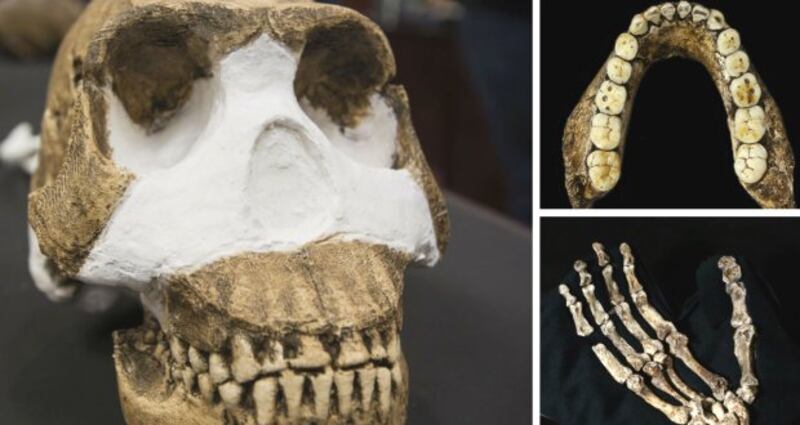Excavations in a cave in South Africa have unearthed a new species of early human. The find is extraordinary because it suggests that this species intentionally placed the bodies of its dead in a separate chamber at the back of the cave.
Only modern humans and the earlier Neanderthals buried their dead in a consistent way, but while Neanderthals lived between 30,000 and 250,000 years ago, this new species, Homo naledi walked the earth possibly as early as 2-2.5 million years ago.
It was not a single find but a huge assemblage of fossils, the largest find of its kind yet made in Africa. So far the excavation has given up 1,550 fossils with parts from at least 15 individuals of Homo naledi and the researchers involved believe that there could be hundreds if not thousands of individuals deposited in this primitive tomb.


The human ancestor is also important because it represents a mix of quite modern attributes such as upright walking and human-like feet and hands while its skull and jaws were much more primitive.
Given the human-like characteristics the research team believes that it should be grouped amongst the other Homo species including Homo habilis that lived 2.8 million years ago and Homo sapiens that emerged 200,000 years ago.
The creature also had a small brain about the size of an orange, its discoverers write on Thursday in research papers published in the journal eLife. It is also published in National Geographic magazine.
Most things about the Rising Star cave complex are extraordinary, said lead author Prof Lee Berger of the University of the Witwatersrand.
Located about 50 km northwest of Johannesburg , the cave is almost 100 metres long but the Dinaledi Chamber that holds the fossil remains is at the very rear of the complex.
So far the team has only excavated a metre square by 50cm deep, but the chamber is 12 meters long. “There is a lot more to be excavated,” said lead author Prof Paul Dirks of James Cook University in Australia.
The underground journey to the Dinaledi Chamber is a challenge given the narrow 18cm wide gaps through which you must pass to reach it. Only petite cavers and excavators were able to access the chamber Prof Dirks said. Homo naledi itself was about 1.5 metres tall and weighed about 45kg.
Inside the chamber the fossils are “beautifully preserved”, he said. “The quality of the bone is extraordinary.”
There was no damage to the bones, no predator bite marks or broken bones and there are no other fossils other than those from a few mice and bird remains. “Such a situation is unprecedented in the fossil hominin record,” said Prof John Hawks of the University of Wisconsin-Madison, a senior author.
People often think of early humans as little more than apes who walked upright and might have used simple tools, Prof Berger said. That is why the Rising Star cave finds are so out of the ordinary.
Burial or ritualised deposition of bodies should have been beyond the capabilities of a creature with such a small brain. Yet individuals of all ages are placed within the chamber deep underground where they have lain hidden and undisturbed for perhaps millions of years.












